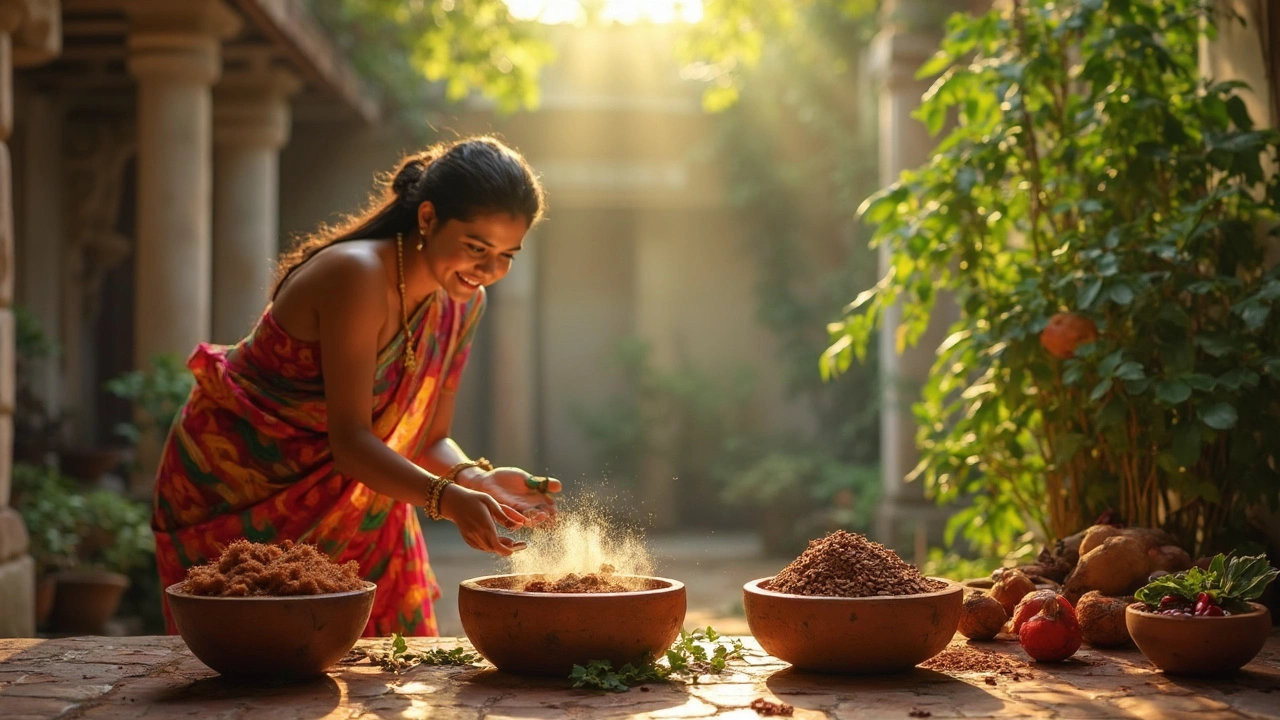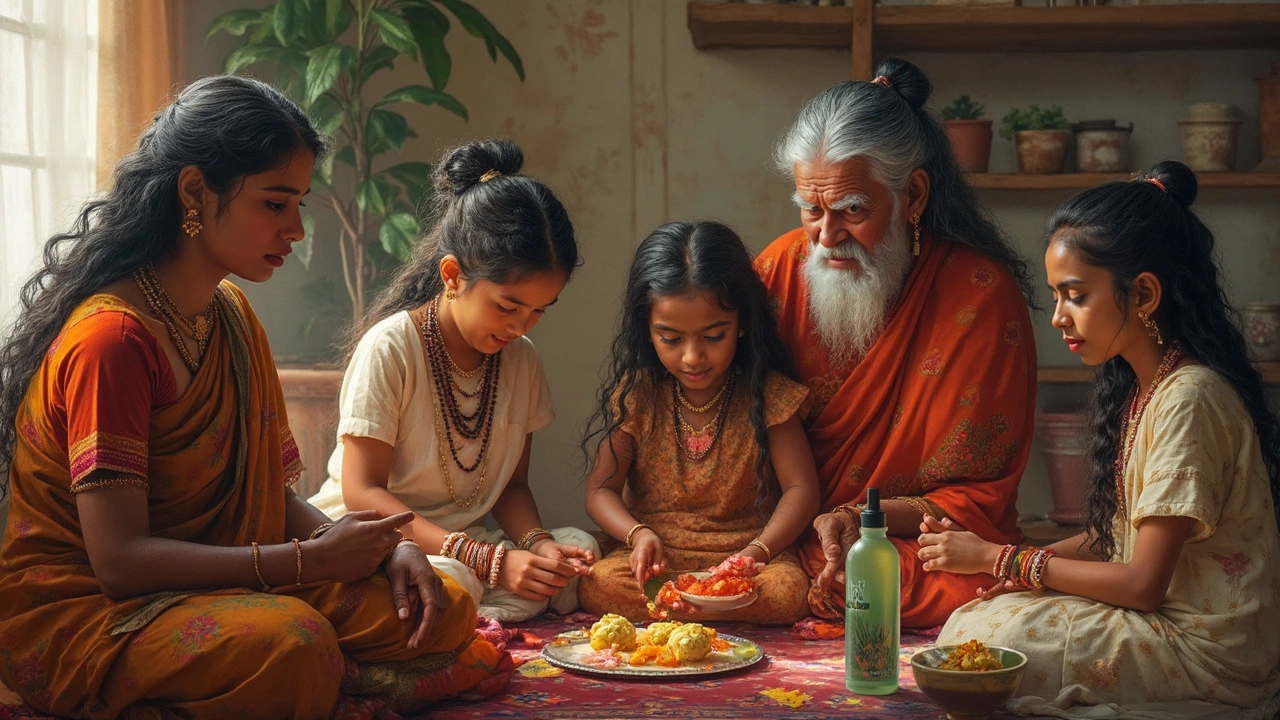
Forget standard bottles of shampoo lined up at the store—what you find in many Indian homes looks totally different. From grandma’s kitchen jars to markets overflowing with herbs, hair washing in India is a tradition, not just a chore. Most people think “shampoo” means a commercial, chemical-rich bottle, but in India, it’s often a scoop of powdered herbs or a handful of soapnut pods.
Why do so many Indians reach for natural stuff? For starters, ingredients like shikakai, reetha, and amla are everywhere, cheap, and effective. And there’s real science: these things clean your hair just like modern shampoos without stripping out natural oils. Some families still follow recipes passed down for generations, complete with playful childhood memories of sticky amla paste and lots of sudsy mess.
If you check what’s inside an Indian bathroom, you might spot a jar of dried herbs, a block of plant soap, or even boiled mixtures cooling on the windowsill. With global brands flooding the market, yes, some do reach for Pantene or Head & Shoulders—but the home remedies haven’t lost their charm. There’s a reason so many people with silky, thick Indian hair swear by powders and pastes, not plastic bottles.
- The Real Hair Washing Staples in India
- Time-Tested Ayurvedic Ingredients
- How These Rituals Help Your Hair
- Trying Indian Hair Washing Methods Yourself
The Real Hair Washing Staples in India
Think most Indians just squeeze out branded shampoo? Not even close. Walk through rural areas or even peek into older city homes, and you’ll see a different lineup of products on bathroom shelves. The classic hair cleaning arsenal includes things you probably haven’t seen at your corner shop.
Indians often reach for botanicals. The real MVPs are:
- Shikakai (Acacia concinna): Dried pods ground into powder, later mixed with water. It cleans scalp and hair with natural saponins, which actually foam up.
- Reetha (Soapnut): These nuts lather as you rub them with water and can be used alone or with shikakai for extra cleansing.
- Amla (Indian gooseberry): Mostly used for its vitamin C content, amla powder is mixed with other staples to keep hair black, thick, and less prone to breakage.
- Fenugreek seeds (Methi): Soaked overnight and ground into a paste, they soothe dry scalp and fight dandruff.
- Hibiscus leaves and flowers: Blended into a slimy, slippery paste that softens hair and adds shine.
Lots of households even have their own favorite ratios for these powders. Some people throw in fresh curd, aloe vera gel, or neem leaves, based on weather or scalp needs.
Here’s how things really look in numbers when it comes to what’s actually used versus the well-known commercial brands:
| Hair Washing Product | Usage (% of Indian homes) | Notes |
|---|---|---|
| Plant-based powders/pastes | 42% | Includes shikakai, reetha, amla, fenugreek, etc. |
| Commercial shampoos | 54% | Primarily urban and younger population |
| Soap bars | 4% | Still used by older generations or in rural belts |
Most combos get mixed with water into a paste right before use—no weird preservatives or perfume. And these staples aren’t just used by aunties. Even guys and kids get their hair scrubbed down with these age-old formulas, especially during the hotter months to control sweat and itchiness. If you think only grandmas stick to these recipes, ask any Indian woman with thick, shiny braids. Odds are, she’s got a container of shikakai at arm’s reach.
Time-Tested Ayurvedic Ingredients
Most folks in India don’t reach for a fancy chemical-laden shampoo. They trust ingredients that their families have sworn by for generations. The names come up again and again: shikakai, reetha (soapnut), amla (Indian gooseberry), neem, and fenugreek. Each one does a different job and works together for real results, not just marketing promises.
Let’s get into what makes these ingredients the go-to for so many Indian households:
- Shikakai – This pod from the acacia tree works like a natural cleanser. It lathers lightly, lifts dirt, and keeps your scalp balanced. Plus, people say it gives you fewer tangles and stronger roots.
- Reetha (Soapnut) – If you want natural bubbles, this is it. Soapnut is loaded with saponins, which are just natural soaps. It foams up and strips away grime but doesn’t leave your hair feeling like hay.
- Amla – You hear about this one everywhere in Indian hair care. Amla is packed with vitamin C and antioxidants. Folks use it to boost hair shine, help growth, and hold onto dark color longer. Some say it keeps you from greying too early.
- Neem – Got a flaky scalp? Neem is your friend. Known for its antifungal and antibacterial power, it keeps dandruff at bay. You’ll see it mixed into pastes or even as oil treatments before washing.
- Fenugreek (Methi) – These little seeds are soaked and ground to add some major slip and softness. If your hair tends to feel dry after a wash, try this the Indian way—it works like a charm for smoother hair.
Here’s a quick look at what these ingredients actually bring to your wash routine:
| Ingredient | Main Benefit | How It's Used |
|---|---|---|
| Shikakai | Cleanses, strengthens roots | Powder or liquid, mixed with water |
| Reetha | Natural lather, removes oil | Whole pods boiled, or powder |
| Amla | Boosts shine, slows greying | Powder mixed into paste |
| Neem | Fights dandruff | Leaves boiled, powder, or oil |
| Fenugreek | Adds softness, reduces dryness | Soaked and ground seeds |
Most families make their own blends of these, based on what problem they want to fix. Some folks even throw in hibiscus petals or curry leaves for specific perks. What makes these truly different is there’s little to no chemical waste, no artificial scents—just pure plant power that’s been tried and tested for hundreds of years.
As a tip, if you're trying these at home, rinse thoroughly—herb bits might stick the first couple of times. But the results? Well, a lot of people with glossy, thick hair in India are proof that this stuff actually works.

How These Rituals Help Your Hair
Ever wondered why Indian hair care routines seem to work magic even without all the fancy products? There’s a real reason. Using stuff like reetha (soapnut), shikakai, and amla is more than just tradition—it’s backed by science and a bit of common sense.
Many of these natural cleansers help your scalp in ways that regular shampoos just can't. Reetha, for instance, has saponins that give it a natural foam and gently lift away dirt. No sulfates, no fake fragrances. Shikakai is slightly acidic, which means it doesn’t mess up your scalp’s natural pH balance. And amla packs in vitamin C, which actually feeds your hair roots and helps with strengthening.
"Ayurvedic hair washing routines not only cleanse but also maintain natural oils, so hair stays healthy and less prone to damage," says Dr. Aparna Joshi, an Ayurvedic practitioner from Pune.
People who regularly use these methods see fewer split ends and less dandruff. No kidding, a small Indian study published in 2022 found that participants who washed with herbal powders reported 30% less scalp irritation than those using regular shampoo.
Check this out if you like hard numbers:
| Method | Frequency of Hair Wash | Reported Scalp Irritation (%) | Hair Breakage (%) |
|---|---|---|---|
| Herbal Powders (reetha, shikakai, amla) | 2x/week | 10% | 8% |
| Chemical Shampoo | 2x/week | 40% | 22% |
Here’s how these Indian hair washing rituals really stack up:
- Preserve your scalp’s natural moisture (it feels less dry)
- Strengthen roots and strands over time
- Reduce flaky scalp and annoying itchiness
- Make hair softer and shinier without heavy residues
If you're struggling with dull, itchy, or weak hair, swapping out your bottle for a scoop of herbal shampoo might just be the trick you need. It’s not just about what you ditch, but what you gain—healthier, happier hair without the downsides.
Trying Indian Hair Washing Methods Yourself
If you want to try what millions in India do to clean their hair, you don’t need to hunt for rare ingredients or become an ayurveda expert. Most stuff you need is simple, easy to find online, or even at a well-stocked Asian or Indian grocery. Here’s how you can jump in:
- Soapnut (Reetha) Wash: Take about 8-10 dried reetha pods, crack them, and soak overnight in two cups of water. Next morning, boil this to get a brownish liquid, let it cool, then strain. Massage it into wet hair, just like you would with a regular shampoo. It lathers up, removes oil and dirt, and rinses out easily.
- Shikakai Powder Paste: Mix 2-3 tablespoons of shikakai powder with enough water (or yogurt) to make a runny paste. Apply to scalp and hair, leave it on for a few minutes, then rinse well. Shikakai is pretty mild, so it’s great even for sensitive scalps.
- Amla and Hibiscus Combo: Crush a handful of hibiscus leaves with a tablespoon of amla powder and some water (or use fresh amla or dried if you can get it). This paste boosts shine and cuts down on scalp itch.
These methods avoid all those harsh chemicals that strip your hair’s natural oils—one reason why people see less hair fall and dryness. Got colored or treated hair? These natural washes are safe. Plus, they’re way less likely to mess with your scalp’s natural barrier.
If you’re curious about how popular these ingredients actually are, check out this data pulled from a 2023 health survey in India:
| Ingredient | Percentage Who Use It Regularly |
|---|---|
| Reetha (Soapnut) | 37% |
| Shikakai | 41% |
| Amla | 22% |
| Commercial Shampoo | 68% |
So even though commercial shampoos are gaining popularity, traditional options still have a massive presence. If you try these at home, you might notice your hair gets softer, shinier, and breaks less. Quick tip: always rinse super well, because these mixes can leave a bit of residue if you miss a spot. And if you’re worried about time, most people find making these mixes hardly takes more than 10-15 minutes tops—even faster once you get the hang of it.
Don’t forget, store these mixes in the fridge if there’s any left over, and use them within 2-3 days for best results. Once you get used to it, reaching for that jar of herb powder becomes just as normal as grabbing a bottle off the shelf. Give these methods a shot if you want to see what the real deal is with Indians and their famous hair.





Rohan Talvani
I am a manufacturing expert with over 15 years of experience in streamlining production processes and enhancing operational efficiency. My work often takes me into the technical nitty-gritty of production, but I have a keen interest in writing about medicine in India—an intersection of tradition and modern practices that captivates me. I strive to incorporate innovative approaches in everything I do, whether in my professional role or as an author. My passion for writing about health topics stems from a strong belief in knowledge sharing and its potential to bring about positive changes.
view all postsWrite a comment